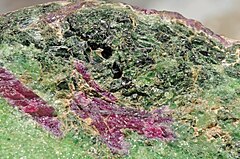Tschermakite
| Tschermakite | |
|---|---|

|
|
| General | |
| Category | Silicate mineral (amphibole) |
|
Formula (repeating unit) |
☐Ca2(Mg3Al2)(Si6Al2)O22(OH)2 |
| Strunz classification | 9.DE.10 |
| Crystal system | Monoclinic |
| Crystal class | Prismatic (2/m) (same H-M symbol) |
| Space group | B2/m |
| Unit cell | a = 9.762(6) Å b = 17.994(12) Å c = 5.325(6) Å; β = 105.10(8)°; Z = 2 |
| Identification | |
| Color | Medium to dark green to green-black to black, brown (rare) |
| Crystal habit | As prismatic crystals or as reaction rims on other minerals |
| Twinning | Simple or multiple twinning parallel to {100} |
| Cleavage | Perfect on {110} Parting on {100}{001} |
| Fracture | Conchoidal |
| Tenacity | Brittle |
| Mohs scale hardness | 5 - 6 |
| Luster | Vitreous |
| Streak | Pale grey-green |
| Diaphaneity | Transparent |
| Specific gravity | 3.15 |
| Optical properties | Biaxial (-) |
| Refractive index | nα = 1.623 - 1.660 nβ = 1.630 - 1.680 nγ = 1.638 - 1.688 |
| Birefringence | δ = 0.015 - 0.028 |
| Pleochroism | Visible in browns and greens |
| 2V angle | Measured: 60° to 90° |
| References | |
The endmember hornblende tschermakite (☐Ca2(Mg3Al2)(Si6Al2)O22(OH)2) is a calcium rich monoclinic amphibole mineral. It is frequently synthesized along with its ternary solid solution series members tremolite and cummingtonite so that the thermodynamic properties of its assemblage can be applied to solving other solid solution series from a variety of amphibole minerals.
Tschermakite is an end-member of the hornblende subgroup in the calcic-amphibole group. Calcium-rich amphiboles have the general formula X2-3 Y5 Z8 O22 (OH)2 where X=Ca, Na, K, Mn; Y=Mg, Fe+2, Fe+3, Al, Ti, Mn, Cr, Li, Zn; Z=Si, Al (Deer et al., 1963). The structure of tremolite (Ca2Mg5(Si8O22)(OH,F)2), another calcic amphibole, is commonly used as the standard for calcic amphiboles from which the formulae for their substitutions are derived. The wide range in variety of minerals classified in the amphibole group is due to its great ability for ionic replacement resulting in a widely varying chemical composition. Amphiboles can be classified on the basis of the substitution of ions on the X site as well as the substitution of AlAl for Si(Mg, Fe+2). In the calcium amphiboles like tschermakite Ca2(Mg, Fe2+)3Al2 (Si6 Al2) O22(OH)2, the predominant ion in the X position is occupied by Ca as in tremolite, while the substitution MgSi<->AlAl occurs on the Y and the tetrahedral Z site.
Hornblendes are the most common of the amphiboles and are formed in a wide range of Pressure-Temperature environments. Tschermakite is found in eclogites and ultramafic igneous rocks as well as in medium to high-grade metamorphic rocks. The mineral is widespread throughout the world but has most notably been studied in Greenland, Scotland, Finland, France, and Ukraine (Anthony, 1995). Because amphibole minerals like Tschermakite are hydrous (contain an OH group), they can break down to denser anhydrous minerals like pyroxene or garnet at high temperatures. Conversely, amphiboles can be recomposed from pyroxenes as a result of crystallizing igneous rocks as well as during metamorphism (Léger and Ferry, 1991). Because of this important quality, P-T conditions have repeatedly been calculated for the crystallization of hornblendes in calc-alkaline magmas (Féménias et al., 2006). In addition to studying tschermakitic content in its natural occurrences, geologists have frequently synthesized this mineral in order to further calculate its place as an endmember hornblende.
...
Wikipedia
